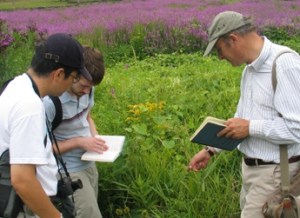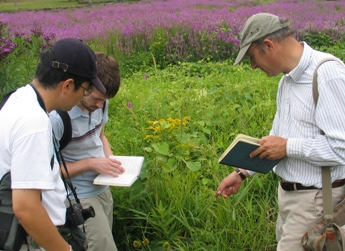
Photo by A. Miller-Rushing.
Susan Peters, who moved from the East Coast to Tucson, Ariz., a couple of years ago, calls her adopted town an “oasis” — never mind that it only gets 12.6 inches of rain each year on average. “I have a very green, beautiful yard with desert-adapted plants, not the East Coast kind of thing,” she says.
She especially likes her 35-year-old saguaro cactus — the kind “you always see in Westerns,” she says. But if her cactus is ever going to land a starring role in the movies, it’s going to need to grow some arms, and Peters says that could take another 40 years. It’s also going to require water — lots of it, and somehow it doesn’t look as if that’s in the cards. In recent decades, the Tucson area has suffered the grip of a combination of sustained drought and high temperatures possibly unrivaled since medieval times.
As they say in the movies, “the West is changing,” and so is the East, and everything in between — and this includes those most dependable bellwethers, the seasons. Now Susan Peters is joining a posse of citizen scientists who are helping track these changes, and their many implications for plants and people alike.
Spring is arriving ever earlier — an average of one day earlier each decade since the 1950s — and for areas surrounding cities, the advance of the seasons is even more dramatic. In February, researchers at the University of Maryland reported that in areas around East Coast cities, spring has been arriving five days earlier than in rural areas, and summers have been lingering 10 days longer, due to the combined effects of climate change and the urban heat island effect.
And it’s not just seasonal temperatures that are changing, it’s also rainfall patterns, moisture availability, and the timing of meteorological events such as snowmelt. An early spring may sound like something to celebrate, but scientists say sudden shifts in any of these may throw Mother Nature for a loop.
Scientists from Stanford and the University of Maryland, for example, have found that unseasonably early snowmelt in the Colorado mountains causes whole stands of wildflowers to pop up too soon, only to be devastated by early spring frosts. The resulting shortage of flowers for forage can ricochet to affect pollinators like bees, butterflies, and hummingbirds that must either starve, or go elsewhere. Fewer pollinators means fewer plants, triggering a cascade that could lead to an avalanche of regional extinctions.
Too bad for the bugs, but could it affect humans? Most definitely, says Andrew Elmore, an assistant professor of landscape ecology at the University of Maryland Center for Environmental Science. Imagine what would happen, for example, if an important food crop started to flower “at a time of the season before the bugs that pollinate that plant had been hatched.” No pollinators means no fruit — and that means hungry people. “It would be really bad,” Elmore says.
Still, relatively little is known about how climate change is impacting natural cycles in living things. Enter Susan Peters and her fellow citizen scientists who have signed on with the National Phenology Network. (Phenology is just an old fashioned way of saying the study of “the timing of cycles of nature.”) Peters, whose background is in corporate management, has offered her garden as one of the first stops on the Network’s freshly minted Tucson Phenology Trail, the first such effort in the U.S. The trail includes stops at University of Arizona’s Botanical Gardens and Biosphere II, the ecological science station on the outskirts of the city.
LoriAnne Barnett, outreach coordinator for the Phenology Network, says researchers have selected and tagged prominent specimens of eight plant species around town for Peters and her fellow volunteers to monitor. After a brief training, participants like Peters will take just a few minutes every week to record what they see in a booklet that guides them through all the key observations necessary to provide researchers with usable information. They’ll upload their observations over the internet or via smartphone to a massive phenology database.
Barnett says these observations will give scientists important details on the plants’ lives that can only be accurately perceived up close and in person, such as the exact date when blossoms unfurl completely. Even careful reporting on periods of time when nothing appears to happen in a plant will be important to research. She’d like to see other cities pick up the concept.
Altogether, scientists in the Network are watching more than 200 plant species, plus birds and bugs, and Elmore believes having a large number of observers will pay off, though it will take time. Ten years of observations from thousands of participants in the eBird project, for example, has shown that birds have been arriving nearly a full day earlier for each degree the temperature rises.
Peters says she can already see changes, though her evidence is only anecdotal. “I have an elderly aunt and an uncle who have lived here for 60 years now, and they keep telling me that what I’m experiencing is different from what they remember,” she says. By their recounting, Peters says, cacti and humans alike could count on a brisk shower that would arrive, like clockwork, “every single summer afternoon.” Not so any more.
It doesn’t bode well for the saguaros, but then, their work in motion pictures may be drying up. I’ve heard they can do things with the green screen that a cactus in a real desert could never dream.



